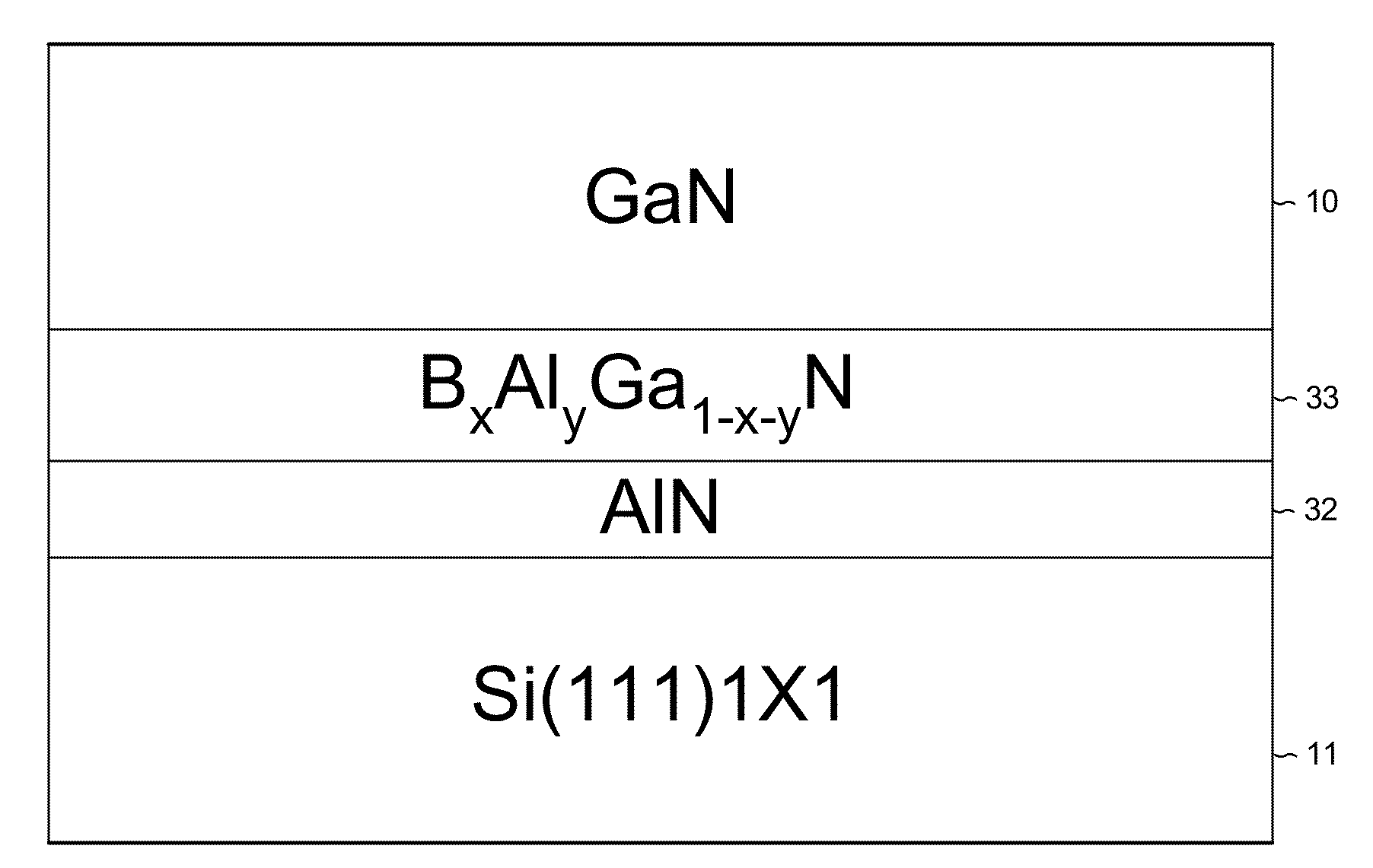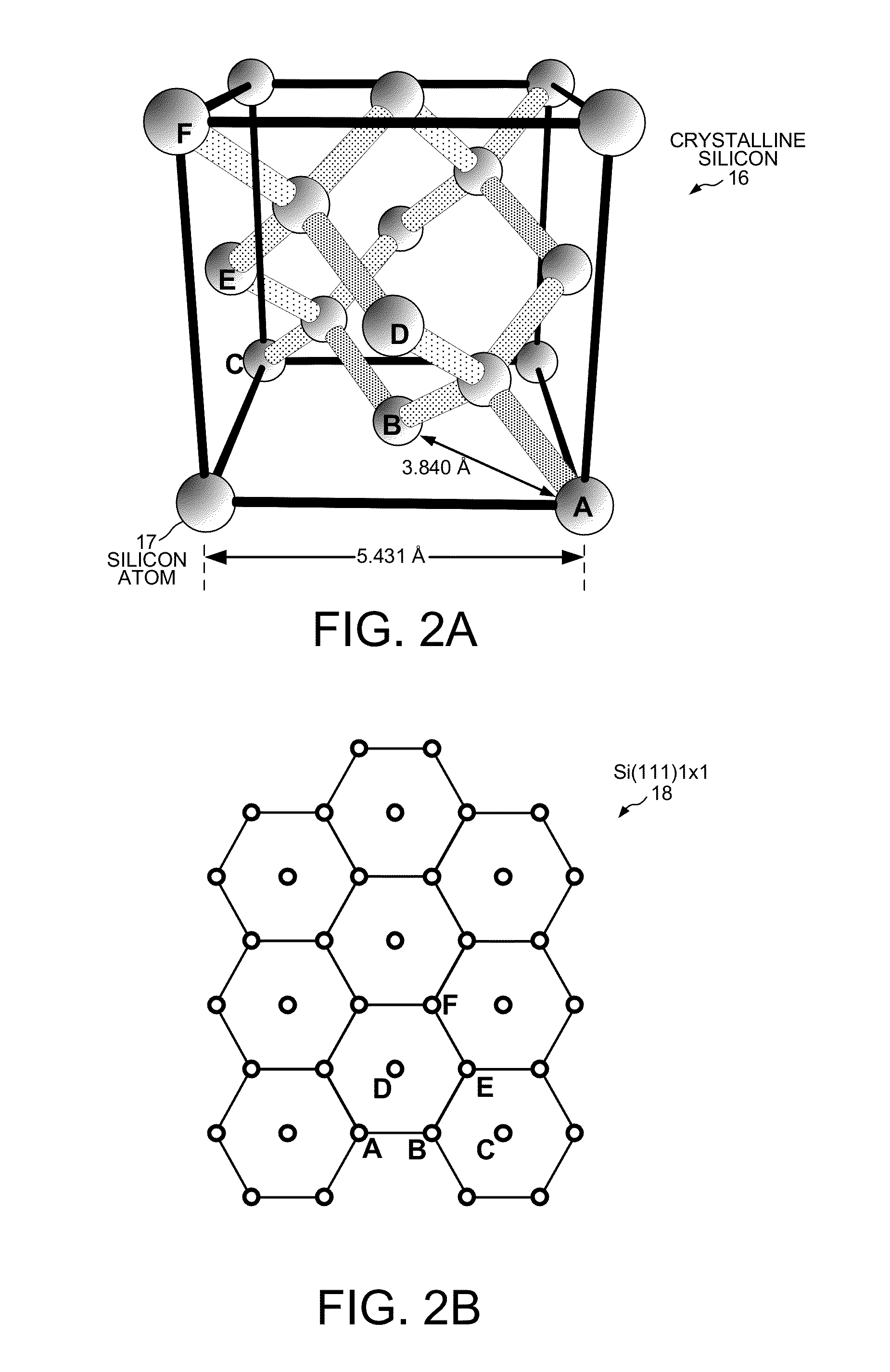Boron-Containing Buffer Layer for Growing Gallium Nitride on Silicon
a gallium nitride and buffer layer technology, applied in the direction of basic electric elements, electrical apparatus, semiconductor devices, etc., can solve the problems of reducing gan is not well suited for epitaxial growth directly on a silicon substrate, and the boron-containing buffer layer is a costly manufacturing step, so as to reduce the size of the wurtzite-type crystal latti
- Summary
- Abstract
- Description
- Claims
- Application Information
AI Technical Summary
Benefits of technology
Problems solved by technology
Method used
Image
Examples
first embodiment
[0034]FIG. 1 is a schematic diagram showing the growth of a single crystal GaN layer 10 on buffer layers over a silicon substrate 11 in the present invention. A buffer layer of boron-aluminum nitride (BxAl1-xN) 12 is first grown on the silicon substrate 11. Then higher buffer layers of aluminum gallium nitride (AlxGa1-xN) 13 are grown over the boron-aluminum nitride layer 12. Finally, the GaN layer 10 is grown over the top layer of aluminum gallium nitride 13. In some embodiments, the GaN layer includes several sublayers. The buffer layer of boron-aluminum nitride 12 is made up of a lower initial nucleation layer 14 and thicker upper layers 15.
[0035]There are several reasons for first growing buffer layers on a silicon substrate before the gallium nitride (GaN) layer 10 is grown. First, meltback etching of the silicon substrate 11 by gallium occurs if the gallium is allowed to react directly with the silicon substrate. The reaction between gallium and silicon results in poor crystal...
second embodiment
[0073]FIG. 14 is a schematic diagram showing the growth of single crystal GaN layer 10 on buffer layers over a silicon substrate 11 in the present invention. A buffer layer of aluminum nitride (AlN) 32 is first grown on the silicon substrate 11. Then higher buffer layers of boron aluminum gallium nitride (BxAlyGa1-x-yN) 33 are grown over the aluminum nitride layer 32. Finally, the GaN layer 10 is grown over the top layer of boron aluminum gallium nitride 33.
[0074]By adding boron to reduce the lattice size of AlGaN, more compressive stress can be built up in thinner BAlGaN layers between the AlN and the GaN. The smaller lattice size of the BAlGaN crystal is used to build up compressive stress by growing successive buffer layers of boron aluminum gallium nitride (BxAlyGa1-x-yN) 33 with increasingly larger lattice sizes. The lowest BAlGaN buffer layer has the most amount of boron and least amount of gallium, which produces the shortest cell unit length. The composition of each higher b...
third embodiment
[0075]In a third embodiment, boron gallium nitride (BxGa1-xN) is used instead of boron aluminum gallium nitride (BxAlyGa1-x-yN) as a buffer between the AlN layer and the GaN layer. The lowest BGaN buffer layer has the most amount of boron and the least amount of gallium. The composition of each higher buffer layer of BGaN contains more gallium and less boron in order to generate ever larger lattice sizes.
PUM
| Property | Measurement | Unit |
|---|---|---|
| thick | aaaaa | aaaaa |
| diameter | aaaaa | aaaaa |
| diameter | aaaaa | aaaaa |
Abstract
Description
Claims
Application Information
 Login to View More
Login to View More - R&D
- Intellectual Property
- Life Sciences
- Materials
- Tech Scout
- Unparalleled Data Quality
- Higher Quality Content
- 60% Fewer Hallucinations
Browse by: Latest US Patents, China's latest patents, Technical Efficacy Thesaurus, Application Domain, Technology Topic, Popular Technical Reports.
© 2025 PatSnap. All rights reserved.Legal|Privacy policy|Modern Slavery Act Transparency Statement|Sitemap|About US| Contact US: help@patsnap.com



